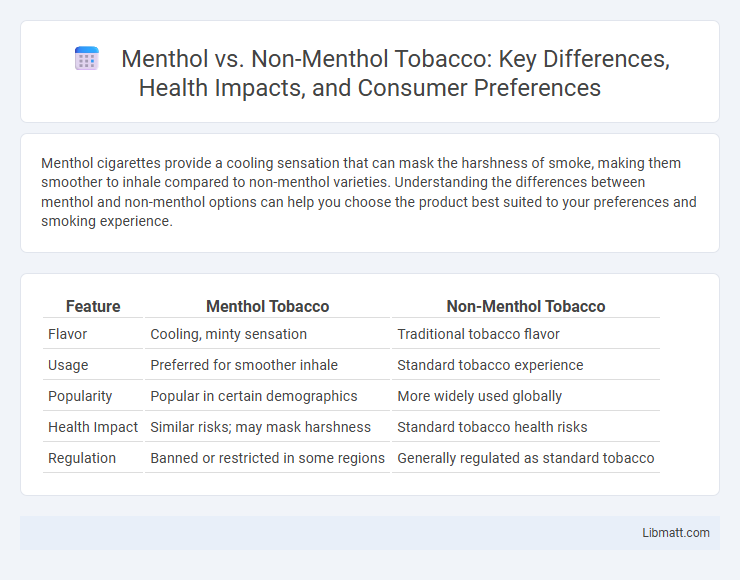Menthol cigarettes provide a cooling sensation that can mask the harshness of smoke, making them smoother to inhale compared to non-menthol varieties. Understanding the differences between menthol and non-menthol options can help you choose the product best suited to your preferences and smoking experience.
Table of Comparison
| Feature | Menthol Tobacco | Non-Menthol Tobacco |
|---|---|---|
| Flavor | Cooling, minty sensation | Traditional tobacco flavor |
| Usage | Preferred for smoother inhale | Standard tobacco experience |
| Popularity | Popular in certain demographics | More widely used globally |
| Health Impact | Similar risks; may mask harshness | Standard tobacco health risks |
| Regulation | Banned or restricted in some regions | Generally regulated as standard tobacco |
Introduction to Menthol vs Non-Menthol
Menthol cigarettes contain a cooling agent derived from mint that provides a distinct sensation and flavor, while non-menthol cigarettes lack this additive and offer a traditional tobacco taste. Research shows menthol can influence smoking behavior by making inhalation smoother, potentially increasing nicotine absorption and addiction risk. Your choice between menthol and non-menthol affects both sensory experience and health implications linked to tobacco use.
What is Menthol?
Menthol is a natural compound derived from mint plants, known for its cooling sensation and minty aroma. It activates cold-sensitive receptors in the skin and mucous membranes, providing a soothing effect commonly used in products like cigarettes, cough drops, and topical analgesics. Menthol's ability to impart a refreshing taste and reduce throat irritation distinguishes it from non-menthol varieties in tobacco and consumer goods.
Key Differences Between Menthol and Non-Menthol
Menthol cigarettes contain menthol, a compound derived from mint oils that produces a cooling sensation and numbs the throat, making the smoke feel smoother compared to non-menthol cigarettes. Non-menthol cigarettes lack this additive, resulting in a harsher, more straightforward tobacco flavor and sensation. The presence of menthol can also impact nicotine absorption and influence smoker preferences and addiction patterns.
Sensory Experience: Flavor and Aroma
Menthol cigarettes deliver a distinctive cooling sensation that enhances flavor perception and provides a minty aroma, creating a smoother sensory experience compared to non-menthol variants. Non-menthol cigarettes emphasize the natural tobacco taste and aroma, often described as robust and earthy without the added cooling effect. The choice between menthol and non-menthol fundamentally alters the flavor profile and aromatic qualities, influencing smoker preference and sensory satisfaction.
Health Impacts: Menthol vs Non-Menthol
Menthol cigarettes contain cooling agents that can mask the harshness of smoke, potentially leading to deeper inhalation and increased toxin exposure compared to non-menthol cigarettes. Studies indicate that menthol smokers may have a harder time quitting due to menthol's addictive properties and throat-soothing effects, which could contribute to prolonged tobacco use. Understanding the health impacts of menthol versus non-menthol cigarettes is vital for assessing personal risks and making informed choices about tobacco use.
Popular Products and Brands
Popular menthol cigarette brands include Camel Crush and Kool, renowned for their distinctive cooling sensation that appeals to smokers seeking a refreshing experience. Non-menthol options dominate the market with prominent brands like Marlboro and Newport, offering classic tobacco flavors favored by the majority of smokers. Your choice between menthol and non-menthol products will depend on flavor preference and brand loyalty within these leading tobacco companies.
User Preferences and Demographics
User preferences for menthol versus non-menthol products vary significantly across demographics, with younger adults and women showing higher affinity for menthol flavors due to their cooling sensation and perceived freshness. Studies indicate that menthol cigarettes are disproportionately preferred by African American smokers, reflecting cultural and targeted marketing influences. Your choice between menthol and non-menthol often aligns with sensory preferences and social factors within specific demographic groups.
Regulatory Considerations and Bans
Menthol cigarettes face stricter regulatory considerations due to their higher appeal among youth and potential for increased addiction, leading to bans in regions such as the European Union, Canada, and certain U.S. states. Non-menthol tobacco products generally encounter fewer restrictions, though all tobacco products are subject to health warnings and advertising limitations. Understanding these regulatory landscapes helps you navigate compliance and anticipate shifts in market availability.
Smoking Cessation: Effectiveness and Challenges
Menthol cigarettes can make smoking cessation more challenging due to the cooling sensation that reduces the harshness of smoke, potentially increasing nicotine addiction and dependence. Non-menthol cigarettes lack this sensory effect, which may result in slightly higher quit rates among smokers attempting to cease. Your success in quitting smoking may depend on addressing the unique cravings and withdrawal symptoms associated with menthol's impact on nicotine intake.
Future Trends in Menthol and Non-Menthol Products
Future trends in menthol and non-menthol products highlight a growing shift toward non-menthol options driven by regulatory restrictions and increasing consumer health awareness. Innovations in flavor technology and reduced-risk product development are expanding alternatives that mimic menthol's sensory effects without its drawbacks. Market analysis projects rising demand for customizable and nicotine-free variants, reflecting evolving preferences across demographics and global markets.
menthol vs non-menthol Infographic

 libmatt.com
libmatt.com